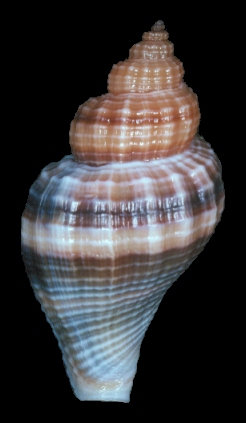| In my article The Florida Crown Conch, in the January-February
issue of the Shell-O-Gram,
I discussed my experiences with Melongena
corona (Gmelin, 1791). I had concluded that,
in large part, with regards to this species, food makes the form.
At the end of the story, I asked readers for any additional
information they might have on forms from a little visited area
of South Florida. In response to the request, I received a
spectacular selection of large Keys forms, and rarely collected
transitional forms from Florida Bay at the south tip of Florida.
Dr. Henry McCullagh of Jacksonville has
visited most of the coast between Chokoloskee and Key Largo, an
area largely missed by most authors discussing Melongena
corona. It's also an area I haven't been
able to sample.
In the gift box were two very enlightening
lots.
 The
first was from San Pedro Bay, at Plantation Key, near Islamorada.
From this lagoon in the upper Keys, Dr. McCullagh found snails
similar to the spineless "aspinossa"
forms that Dall named over a hundred years ago, and that I'd
found in mangrove shallows in the Keys. The exciting thing was,
they were not all the 40 to 60 mm forms I would expect. Included
were rotund specimens reaching 110 mm. Some were
indistinguishable from specimens I've collected in my own
backyard, Tampa Bay. The
first was from San Pedro Bay, at Plantation Key, near Islamorada.
From this lagoon in the upper Keys, Dr. McCullagh found snails
similar to the spineless "aspinossa"
forms that Dall named over a hundred years ago, and that I'd
found in mangrove shallows in the Keys. The exciting thing was,
they were not all the 40 to 60 mm forms I would expect. Included
were rotund specimens reaching 110 mm. Some were
indistinguishable from specimens I've collected in my own
backyard, Tampa Bay.
He observed that the smaller, typical forms,
as would be expected, fed on Batillaria
and small bivalves. Larger forms, to 150 mm, fed on the smaller Melongena
of the same colony! These larger forms were often barrel-shaped
and with the shoulder and basal spines we associated with the
west coast Melongena.
A second lot in my gift box was from a beach
in Florida Bay, about 16 miles northwest of Key Largo. Here again
were Melongena similar
to the spineless form, but attaining a larger size when preying
upon their own species. A range of forms, as in San Pedro Bay,
was found.
Dr. McCullagh found that the spineless forms
prevail until one gets north of Cape Sable. Northward from where
the Shark River meets the Gulf, in his words, "the
beautiful, heavy, trigonal and hugely spinose forms start and
extend to the Everglades/Marco area."
He points out that oyster bars, where I've
found the largest forms, do not occur in Florida Bay of the Keys.
It seems the snail has found another way to achieve a large size
- cannibalism! |